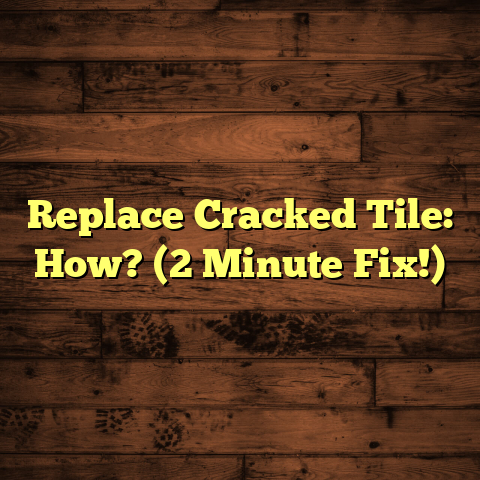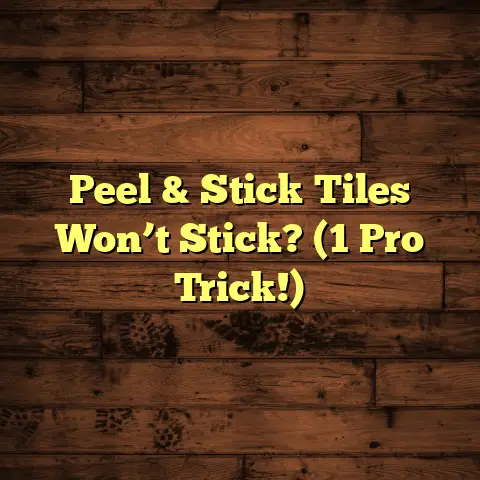Why Do Wood Floors Creak? (4 Fixes Now!)
Imagine it’s late at night, and you’re tiptoeing across your living room, trying not to wake the kids.
But with every step you take, the wooden floor beneath you announces your presence with a series of loud creaks, echoing through the silence of the house.
You pause, wondering if it’s time to invest in new flooring, or if there’s a simpler solution to this annoying nocturnal symphony.
This dilemma is one many homeowners face, and it leads us to the pressing question: Why do wood floors creak?
Let’s dive into the world of wood floors and explore the reasons behind those telltale sounds, and more importantly, what you can do about it.
Understanding the Anatomy of Wood Floors
Alright, let’s get down to the nitty-gritty. Understanding what makes up your wood floor is the first step in silencing those creaks.
We’re talking about everything from the type of wood used to how it was installed.
Think of it like this: you can’t fix a car without knowing its parts, right?
Types of Wood & Installation
First off, there’s solid hardwood, engineered hardwood, and even wood-look laminate. Each has its own set of characteristics.
Solid hardwood, like oak or maple, is a single piece of wood. It’s durable but also reacts more to changes in humidity.
Engineered hardwood has a thin layer of real wood on top of multiple layers of plywood. This makes it more stable and less prone to warping.
Laminate, well, that’s a different beast altogether, often made of composite wood pressed together with a printed image of wood grain on top.
Installation methods also play a huge role.
Nail-down, glue-down, and floating floors all behave differently over time.
A poorly installed floor, regardless of the material, is practically begging to creak!
Wood’s Natural Movement
Here’s a fun fact: wood is a living material, even after it’s been turned into flooring.
It expands when it’s humid and contracts when it’s dry.
This constant movement puts stress on the fasteners and the subfloor, which can lead to creaking.
I’ve seen floors that buckle so bad in summer that you could trip over them.
Then, in winter, the gaps between the boards are wide enough to lose a dime in.
According to the Forest Products Laboratory, wood can change dimensionally by as much as 5% to 10% depending on the species and how it’s cut.
The Subfloor’s Supporting Role
Now, let’s talk about the unsung hero beneath your beautiful wood floor: the subfloor.
This is usually made of plywood or OSB (oriented strand board) and provides the foundation for your flooring.
A poorly installed or aging subfloor can cause all sorts of problems, including – you guessed it – creaking.
If the subfloor isn’t properly secured to the joists (those horizontal beams that support the floor), it can move independently, causing the floorboards above to rub and squeak.
I’ve seen subfloors that were so rotten they were basically dust.
No wonder the floors above were creaking like an old pirate ship!
Common Causes of Creaking Floors
Okay, now that we know the anatomy of a wood floor, let’s dig into the specific reasons why they start to creak.
Trust me, it’s usually not because your house is haunted (although, that would be a cooler story).
Moisture and Humidity: The Culprits
As I mentioned earlier, wood is sensitive to moisture. When humidity levels rise, wood absorbs moisture and expands.
When they drop, it releases moisture and contracts.
High humidity can also lead to mold and mildew, which can weaken the subfloor and make it more prone to movement.
I once inspected a home where the crawl space was so damp that mushrooms were growing under the floor!
Needless to say, the floors above were creaking like crazy.
Nail and Fastener Issues: The Loose Connections
Over time, nails and screws that hold your floorboards in place can loosen.
This is especially common in older homes where the fasteners have been subjected to years of vibration and movement.
Loose fasteners allow the floorboards to move independently, causing them to rub against each other or the subfloor, resulting in that annoying creaking sound.
I often find that the nails have simply rusted away, leaving nothing to hold the floorboards in place.
Subfloor Movement: The Shaky Foundation
A subfloor that isn’t properly secured to the joists can also cause creaking.
This can happen if the original fasteners were too short, if the joists have settled over time, or if the subfloor itself is damaged or warped.
When the subfloor moves, it takes the floorboards with it, creating friction and noise.
I’ve even seen cases where the subfloor was never glued to the joists in the first place, making it incredibly unstable.
Wear and Tear: The Inevitable Aging Process
Finally, let’s not forget about good old wear and tear. Over time, even the best-installed wood floors will start to show their age.
Foot traffic, furniture, and general use can all contribute to wear and tear, leading to loose fasteners, gaps between floorboards, and a general weakening of the floor structure.
In older homes, the floor joists themselves may start to sag or settle, causing unevenness and creaking.
I’ve worked on homes that are over a hundred years old, and let me tell you, those floors have seen a lot of wear and tear!
Four Effective Fixes for Creaking Floors
Alright, enough with the doom and gloom. Let’s talk about how to actually fix those creaking floors. Here are four practical solutions that I’ve used time and time again.
1. Tightening Loose Nails and Screws: The First Line of Defense
This is often the easiest and most effective solution, especially if the creaking is localized to a few specific spots.
First, you’ll need to identify the areas where the floor is creaking. Walk around the room and listen carefully, marking the spots with tape.
Next, inspect the floorboards in those areas for loose nails or screws. You can usually spot them by looking for slightly raised or protruding fasteners.
If you find loose nails, try hammering them back in. If they don’t hold, replace them with slightly larger nails.
For loose screws, simply tighten them with a screwdriver. If the screw holes are stripped, you can use wood glue and toothpicks to fill the holes before re-inserting the screws.
Here’s a pro tip: use a nail set to drive the nails slightly below the surface of the wood. This will prevent them from sticking up and becoming a tripping hazard.
Tools you’ll need: * Hammer * Screwdriver * Nail set * Replacement nails and screws * Wood glue * Toothpicks
2. Adding Lubrication: The Silent Treatment
Sometimes, the creaking isn’t caused by loose fasteners but by friction between the floorboards themselves.
In these cases, lubrication can work wonders.
The most common lubricant is talcum powder, but graphite powder also works well.
Simply sprinkle the powder into the gaps between the floorboards and use a brush or cloth to work it in.
The powder will reduce friction and eliminate the creaking sound.
For larger gaps, you can use a putty knife to force the powder in.
This is a quick and easy fix that can provide immediate relief.
I’ve used this trick on countless floors, and it’s amazing how effective it can be.
Materials you’ll need: * Talcum powder or graphite powder * Brush or cloth * Putty knife (optional)
3. Screwing Down the Subfloor: The Reinforcement Strategy
If the creaking is caused by a loose subfloor, you’ll need to secure it to the joists.
This involves screwing the subfloor down with long screws that penetrate into the joists.
First, you’ll need to locate the joists. You can usually do this by looking for nail patterns in the floor or by using a stud finder.
Once you’ve located the joists, drill pilot holes through the floorboards and into the joists.
Then, insert long screws (at least 3 inches) through the pilot holes and into the joists.
Make sure the screws are long enough to penetrate at least 1 inch into the joists.
Space the screws about 12 inches apart along each joist.
This will effectively secure the subfloor and eliminate movement.
Be careful not to drill too deep, or you could hit plumbing or electrical wires.
I always recommend turning off the power before starting this project, just to be safe.
Tools you’ll need: * Drill * Drill bits * Stud finder * Long screws (at least 3 inches)
4. Using Shims: The Gap Fillers
Sometimes, the subfloor isn’t resting snugly on the joists, leaving gaps that cause the floor to flex and creak.
In these cases, you can use shims to fill the gaps and provide a solid foundation for the floor.
Shims are thin, tapered pieces of wood that can be inserted into the gaps between the subfloor and the joists.
To install shims, you’ll need to access the area beneath the floor, usually from a basement or crawl space.
Identify the gaps between the subfloor and the joists and insert the shims into the gaps.
Use a hammer to tap the shims in until they are snug but not too tight.
You don’t want to lift the subfloor off the joists.
Once the shims are in place, you can use a utility knife to trim off any excess material.
This is a simple but effective way to eliminate creaking caused by gaps in the subfloor.
I’ve used shims to fix everything from minor creaks to major floor problems.
Tools you’ll need: * Shims * Hammer * Utility knife
When to Call a Professional
Okay, so you’ve tried all the DIY fixes, and your floors are still creaking. What now?
Well, it might be time to call in a professional.
Sometimes, the creaking is a sign of more serious underlying issues that require expert attention.
For example, if the floor joists are damaged or rotting, they may need to be replaced.
This is a major undertaking that is best left to the pros.
Similarly, if the subfloor is severely damaged or warped, it may need to be replaced.
This can also be a complex project that requires specialized tools and knowledge.
Here are some signs that it’s time to call a pro:
- Widespread creaking that doesn’t respond to DIY fixes.
- Visible signs of water damage or rot.
- Sagging or uneven floors.
- Cracked or broken floorboards.
Don’t be afraid to call a professional for a consultation.
A good flooring contractor can diagnose the problem and recommend the best course of action.
It’s better to spend a little money on a professional inspection than to risk making the problem worse with DIY fixes.
I’ve seen homeowners try to fix serious floor problems themselves, only to end up causing more damage and costing themselves more money in the long run.
Embracing a Noisy Home
Let’s face it, no home is perfectly silent. Even with the best efforts, some level of noise is inevitable, especially with wood floors.
Instead of obsessing over every creak and squeak, try to embrace the charm and natural character that wood flooring can offer.
Think of those creaks as part of your home’s unique personality.
They tell a story of years of use, of footsteps and laughter, of memories made and shared.
Of course, that doesn’t mean you should ignore major creaking problems.
But if you’ve addressed the most serious issues and your floors are still making a little noise, try to relax and enjoy the ambiance.
After all, a home is more than just a building. It’s a place where you live, love, and create memories.
And sometimes, those memories come with a little bit of noise.
I always tell my clients that a perfectly silent home is a sterile home.
A little bit of noise is a sign that your home is alive and well.
So, embrace the creaks, enjoy the character, and create some memories!




